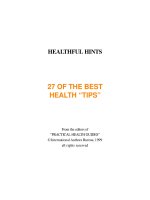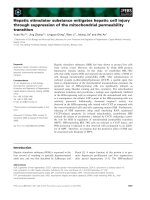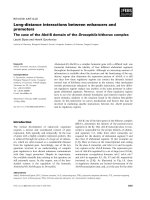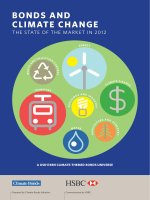Operation of the Air Pollution Index (API), the Air Quality Index (AQI) and the Air Quality Advisory pdf
Bạn đang xem bản rút gọn của tài liệu. Xem và tải ngay bản đầy đủ của tài liệu tại đây (35.36 KB, 6 trang )
GUIDELINE A-3
(formerly 01-04)
Operation of the Air Pollution Index (API), the Air Quality Index
(AQI) and the Air Quality Advisory
Legislative Authority:
Environmental Protection Act, Part I, Section 3(f)
Ontario Regulation 346, Section 4
Responsible Director:
Director, Environmental Monitoring and Reporting Branch
Last Revision Date:
April, 1994
Table of Contents
1.0 INTRODUCTION
2.0 DEFINITIONS
3.0 PURPOSE OF THE AQI AND API
3.1 Purpose of the API
3.2 Purpose of the AQI
4.0 AQI AND API LEVELS AND CONTROL ACTIONS
4.1 API
4.2 AQI
4.3 Control Actions
5.0 METHOD AND FREQUENCY OF REPORTS OF AQI AND API LEVELS
TO THE PUBLIC
5.1 API
5.2 AQI
SYNOPSIS
The Ministry produces two numerical indices based upon current air quality data the
Ontario Air Pollution Index and the Air Quality Index. These indices, although structurally
related, have different objectives and enforcement mechanisms. Authority for the Air
Pollution Index, and for the control measures associated with it, is contained in O.Reg. 346,
S.4. The Air Quality Index is produced and disseminated under the provisions of the
Environmental Protection Act, Part I, Section 3(f). It is used primarily as an information tool.
In addition, when levels of ground level ozone above a threshold level of 80 ppb are observed
or forecast from the Air Quality Index Program, the Ministry will issue Air Quality Advisories.
1.0 Introduction
The Ministry releases two numerical indices based on current measurements of air pollution in
various communities throughout Ontario the Air Pollution Index and the Air Quality Index.
This guideline outlines the objectives of these two indices and describes actions the Ministry shall
take in connection with them to control pollutant emissions to the atmosphere.
2.0 Definitions
Air Pollution Index (API):
A series of numbers expressing the relative levels of air pollution and taking into consideration
one or more contaminants (as provided for under O. Reg. 346). The API protects human health
by triggering control actions designed to curb or prevent air pollution episodes associated with
these contaminants during periods of adverse meteorological conditions.
Air Quality Index (AQI):
A numerical expression of air quality for specific locations in the province derived from air quality
measurements at those locations. To produce the index at a particular location, levels of one or
more contaminants over various critical averaging times are expressed relative to standards
applicable to those contaminants and averaging times to produce a sub-index or sub-indices.
After calculation of each of the sub-index values, the highest of these is taken as the Air Quality
Index. One of the AQI sub-index values may be the API sub-index. If the API sub-index is the
highest of the sub-indices, then the API is the basis of the AQI.
Adverse Meteorological Conditions:
Wind speed, wind direction, turbulence (wind fluctuations) or temperature variations, alone or in
combination, which prevent the efficient dispersal of pollutants into the atmosphere.
Air Pollution Episode:
An occasion when air contamination is at such a level and for such a period of time that the air
contamination may cause increased human sickness and mortality.
Air Pollution Alert System:
A system which warns of deteriorating air quality.
3.0 Purpose of the API and AQI
3.1 Purpose of the API
The API is the basis of an Air Pollution Alert System designed to protect human health. This
system provides a means for controlling emissions of sulphur dioxide and suspended particulate
matter from stationary sources of pollution when adverse meteorological conditions prevail and
elevated ground level concentrations of these contaminants are predicted.
3.2 Purpose of the AQI
The AQI provides communities with information on the current air quality in areas where
monitoring stations are located.
Several of the pollutants included in the AQI come primarily from automobiles, domestic fuel
consumption or long range transport, none of which can be subject to immediate control. In
general, therefore, the AQI cannot be used as a tool for the immediate prevention of air pollution.
However, on occasions when the Ministry predicts air quality problems might occur, the AQI
system may be used to advise owners of sources which are major contributors to the problem.
4.0 API and AQI Levels and Control Actions
4.1 API
Reading Below 32
Interpretation Acceptable Level
Control Action No action necessary
Reading 32 plus; adverse meteorological conditions expected for at least six hours
Interpretation Air Pollution Advisory Level
Control Action Minister may advise significant sources of pollution to prepare for
curtailment of operations
Reading 50 plus; adverse meteorological conditions forecast for at least six hours
Interpretation First Air Pollution Alert
Control Action The Minister, after consulting with the Minister of Health, may order
significant sources to curtail operations
Reading 75 plus; adverse meteorological conditions forecast for at least six hours
Interpretation Second Air Pollution Alert
Control Action The Minister, after consulting with the Minister of Health, may order
further curtailment of pollution sources
Reading 100 plus
Interpretation Air Pollution Episode Level
Control Action The Ministry will order all pollution sources not essential to public health
or safety to close down
4.2 AQI
Reading Interpretation
0 - 15 Very Good
16 - 31 Good
32 - 49 Moderate
50 - 99 Poor
100 plus Very Poor
4.3 Control Actions
On those occasions when the AQI is 32 or higher, and meteorological forecasts indicate that the
Index will remain elevated for a prolonged period due to emissions from certain stationary
sources, the Ministry may request owners of these sources to take action to alleviate the problem.
The Ministry will make such requests on the basis that the pollutant that is causing the Index to
reach 32 or higher is being emitted at concentrations which exceed the Ontario standard or
criterion for that pollutant.
In addition to these public information measures and control actions, the Ministry, in conjunction
with Environment Canada, has developed a special Air Quality Advisory Program which will
inform Ontario residents when concentrations of ground level ozone and related pollutants are
expected to reach unacceptable levels. The Ministry will issue Air Quality Advisories from the
end of April through to mid-September when widespread, elevated concentrations of ground level
ozone in excess of 80 ppb are expected, based on current and forecast information from the
provincial Air Quality Index program.
Advisories will include an Action Statement informing the public what they can do to help, an
Environmental Statement describing the effects of air pollution on the environment, and a Health
Statement regarding the general impacts of air pollution on health.
5.0 Method and Frequency of API and AQI Reports to the Public
5.1 API
The API will be reported to the public when it is the basis of the AQI, and it will be reported as
such (see 2.0, Definition of Air Quality Index).
5.2 AQI
Index readings will be reported to appropriate media outlets, eight times a day. Whenever the
AQI is reported to be 32 or higher, subsequent reports will be released every hour together with
information respecting the probable duration of the 32-or-higher level and the pollutant(s) on
which the AQI is based.

![Tài liệu [ Team LiB ] Configuring Your Safe Senders List The Safe Senders list is part of the Junk E-mail pdf](https://media.store123doc.com/images/document/14/nu/js/medium_jsx1390245650.jpg)







